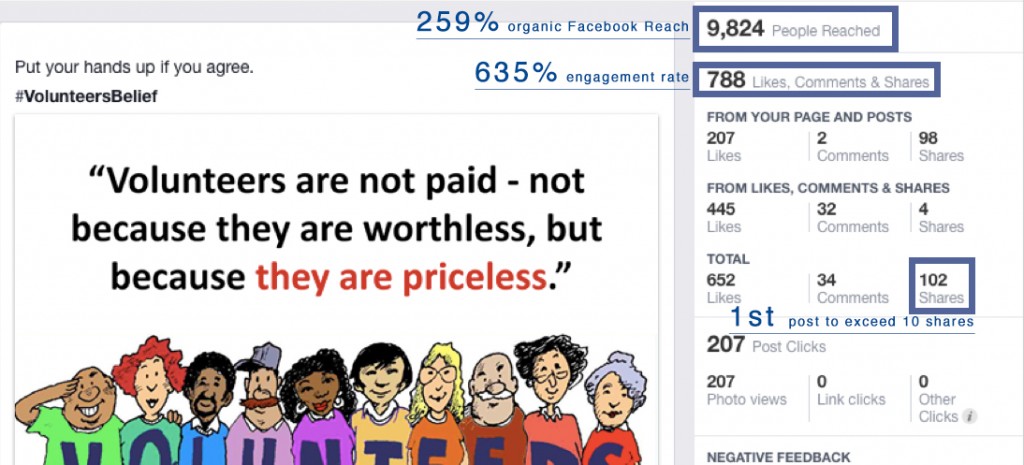If you’re tired of creating the same kind of Facebook posts every week, it’s time you try this Facebook Content Framework to help you create good content on a regular basis.
The post you see above is one of the examples created using this Content Framework which saw an explosive growth in engagement rates, especially in number of shares.
Are you ready?
A Facebook Content Framework of 10 categories
1. Advise
Content containing an advice offers suggestions of the best course of actions to your target audience. They can take ANY content form - text, photo, slides, and more.
For instance, as a Facebook marketing consultant offering advice to the larger marketing and small business community, an advice post will look something like the one above.
Too often, advice often comes in the form of “quotes” or some other form of preaching. Remember how your mom nags at you when you’re young and how annoying you feel that is? That’s usually how preaching makes one feel. So try to avoid overdoing it.
While preaching is the most common form that advice is given, it need not be so. A good example can be less picturesque - the form is not as important as the content.
And while writing this post, I chanced upon another good example:
Good advice tips go beyond both “preaching” and “offering only 1 tip at a time” to suggest actions that your target audience can take to improve a certain situation.
2. Amaze
Content that amazes people are slightly harder for the average business. To amaze people, your content needs to surprise your target audience greatly (note the extent). It can also work if your message is an insightful one.
Most people have a love-hate relationship with babies. And babies make excellent topics - because they’re cute, innocent, and they resemble our somewhat naive past. If you’re in a business where babies are relevant - then you should certainly add this topic into your content arsenal.
I’ll admit that I’m a fan of both The Idealist and baby topics - so the one above certainly caught my eye. Just look at the kind of engagement they got in 9 hours.
Agilent does well to give deep insights to its target audience - their technology is capable enough to check the organ of a historically famed man. Note that the copy here does not say much beyond generating enough interests to get the people to click on the link. The link click-through rate is most likely higher than the engagement rate - 245 likes, 4 comments, and 42 shares.
3. Amuse
Amusing content is pretty self-explanatory. In short, they cause your target audience to find it funny. It can involve various kinds of humour - from the most direct ones to witty puns. 9Gag content is often at the heart of this - but I’d recommend you to use them sparingly (for a non-entertainment business) and only when you really think it is both relevant and good, the kind you’re almost 100% sure that it will work.
This is an example of mine. The client was a nonprofit promoting an event among existing volunteers. The child in the photo became famous as memes became popular in the last few years. Using the child’s photo as a template, I added a simple quote. The results? 80% organic reach compared to the 16% average back then.
Want an example of what NOT to do? The above post shows that perfectly - humour that borders between “funny”, “lame”, and “offensive”, and a topic that is very sensitive in its nature.
Remember, if you want to amuse your target audience, make sure that your post is both relevant and funny.
4. Engage
Engaging content strives to interact with your target audience and usually results in a visible action - such as likes, comments, and shares. This is also the most common and broad category because of its definition. Content in this category can be re-categorised under any of the other 9 categories.
You should define the engagement you want when creating your content. Usually it should be either comments or shares, because they’re definitely harder to meet than mere likes.
Perhaps the most defining part of engaging content is in asking questions. You don’t always need a sassy photo that invites discussion. As long as your question is relevant (note that there are several degrees of relevance, but we’ll talk about that another day), this method always works.
This is another example of mine. When you are striving to increase the number of shares for your post to reach more people, your best bet is to post content that resonates deeply with your target audience. This is hard, but it’s possible if you take some time to think about what is relevant to your business that truly resonates with your target audience.
If you need help, give me a brief description of your business and target audience below. I’ll try to help.
5. Give
As the name suggests, content that gives your target audience something usually culminates in a contest, sweepstake, or discount. A surefire way of generating social ROI through Facebook is to conduct regular sales promotions. This method is used by both small medium businesses and large corporations - there’s a lot you can do for sales promotions on Facebook and I’ll be covering this in a later post.
Ever since Facebook updated its promotion guidelines last October, hosting a timeline contest is now possible and has made the jobs of marketers a lot easier. But the same soft rules still apply: successful contests always offer gifts that are relevant to your business. If you sell ice cream, you should give away ice cream as your prize. If you are an interior design and furniture firm like Produce, you should give away a product that is unique to your business - in this case it was an exclusive set of coasters that was easily produced using their in-house capabilities.
For more contest ideas, read this.
6. Greet
Content that greets your target audience are usually relevant only for festive and special occasions - not your everyday “Good Morning” rituals. Every festive occasion, 2 brands I look to are Oreo and Starbucks.
You don’t need a flamboyant festive post like the big brands - you just need one that makes your target audience feel the festive occasion and love from your business.
7. Inspire
This is my favourite content group and perhaps one of the most popular kinds on Facebook. Inspiration Facebook posts urge your target audience to do something and gives them a renewed sense of hope. This kind of content usually resonates deeply with your target audience and often results in a lot of shares.
In celebration of the event my client was promoting, this post certainly resonated deeply with the volunteers and even with myself since I am a volunteer too. The end result was an organic reach 259% of total number of fans and an engagement rate 635% of the average engagement.
Caveat: Inspirational posts doesn’t work for all the brands. Key is to find which of the 10 works for your brand and focus on the mix!
8. Ride on Trending News
Remember this? It won Oreo big time at the Superbowl last year, generating over 20,000 likes and 15,000 retweets. Yes, you heard it right. It beat all of the heavily touted TV commercials on Superbowl and was the talking point among all the marketers throughout the entire February.
Taking advantage of trending news is hard. It requires a lot of resources and a team of dedicated and intelligent marketers who are always ready to pounce on the latest news. Oreo is seen as the leader in this category.
To quote a local example, 3M Singapore shared the above post during the haze period, when PSI levels reached record highs and the people here were scrambling for a N95 mask to protect themselves from the harmful air. They also offered free tips on how to differentiate the real and effective N95 masks from the fakes, and other tips on how to stay healthy and protect oneself from the haze, endearing themselves to the local community on Facebook.
9. Unite
Uniting your target audience is a difficult task. And it’s even harder to actually measure how united and tight your community is. But there are ways you can promote a greater sense of community among your Facebook fans and attract even more like-minded people to join.
Here’s an example taken from SocialMetric’s workshop - their client’s Facebook Post saw an explosive increase in number of shares within 17 hours of posting, a huge jump from their historical record of less than 10 shares.
In my opinion, content like these should be a mandatory part of your content mix. The reason is because such content promotes a sense of identity and belonging among the fans. We’re humans and we like to be part of a community. It fulfils a social need (Remember Maslow’s Hierarchy of Needs?) I could go on about all the theoretical explanations of how an increased sense of belonging builds a stronger foundation and community for your business, leading to increased ROI in the long term but I think you already understand it, some even better than I do.
10. Warn
Finally, our last content category features warnings. They are more serious than advice and usually they talk about potential dangers that threatens your target audience - job security, health, accidents, hazards, etc.
The most obvious example would come from the Police Force. But it’s definitely not limited to only regulatory agencies. What about your business? If you’re a stock brokerage, you can warn about potential dangers in using “cheaper” alternatives. If you’re selling stuff in a drugstore, you can warn about potential dangers buying from an unauthorised dealer. If you’re selling in-vehicle cameras, you can warn about potential dangers involving an accident and not being able to clear your name. The list goes on.
Disclaimer: The above 10 tips are obtained from the “R” part of SocialMetric’s RIDE Methodology. I attended their workshop in late 2013 where we had some hands-on training to apply the framework in class. It has worked a great deal for me and I hope it does for you.
Questions & Answers
1. Should I post non-branded content?
The short answer is that it depends. The long version includes considerations mainly concerning how often you post, your resources available to create content, and your business type. If you post only once a day, then you should consider reserving most of your content for your brand. If you have lots of resources to spare, you can create lots of branded content with ease. If your business involves mainly legal services, then you might be better off posting more non-branded content such as legal tips. Key to making all these decisions is to balance both your target audience and your interests.
Questions? Comment below!
If you like this article, join our subscribers’ community and you will receive:
- Updates on our blog once a month
- Exclusive Facebook marketing secrets included in the monthly edition
- No fluff, fillers, and spam.



Pingback: Oreo does it again - this time along Cadbury. See how they reacted!
Pingback: STEPS: The secret behind viral Facebook Posts